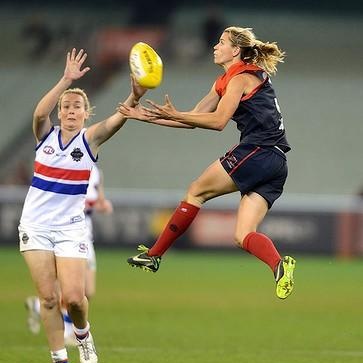Growth without Strength – A key concern effecting female players/athletes
Amongst the various reasons and theories for a higher incidence of female ACL injury (than males) – and indeed the reasons for this are various and interrelated – one that exists is growth in size but with insufficient growth in strength. And that will be the topic that we have a quick discussion of here – as well as what it means in terms of strength training for footy as a female.
‘A possible underlying mechanism for why women have more noncontact ACL injuries than their male counterparts is growth without sufficient power. Men experience a significant increase in neuromuscular strength and coordination as skeletal growth and maturation progresses, a so-called neuromuscular spurt not often observed in women. As bone length and body mass increase in men, they also demonstrate greater neuromuscular control of the knee joint than women, allowing men to better absorb loads. In lay terms, growth results in larger machines in both sexes, but a male subjects mature, they adapt with disproportionately more muscle ‘horsepower’ to match the control demands of their larger machine.’
‘As a result of insufficient neuromuscular adaption, female knees are exposed to greater ground reaction forces and high external knee abduction moments (load), particularly in landing, pivoting, and deceleration sports.’
‘Increased bone length and body mass, in the absence of matching adaptions in neuromuscular strength and coordinated muscle recruitment, exposes the female knee to greater load and likelihood of ACL injury.’
Timothy E Hewett & Gregory D Myer
Prevention of knee injury in women
 What Timothy and Greg are highlighting here ties in with the fact that prior to puberty, incidences in ACL injuries between the 2 genders show no real difference in frequency in similar populations, yet post this maturation stage is when the larger number of female ACL injuries start to occur in comparison to the men. They are indicating that the difference that occurs here is that whilst females bones and muscles grow in size and length just as the guys do during this growth and maturation stage, females do not experience an equal natural growth in strength and neural control over this increased size.
What Timothy and Greg are highlighting here ties in with the fact that prior to puberty, incidences in ACL injuries between the 2 genders show no real difference in frequency in similar populations, yet post this maturation stage is when the larger number of female ACL injuries start to occur in comparison to the men. They are indicating that the difference that occurs here is that whilst females bones and muscles grow in size and length just as the guys do during this growth and maturation stage, females do not experience an equal natural growth in strength and neural control over this increased size.
Men often experience a similar problem to this – namely size and strength without stability – as a result of poor training practices, such as lots of machine weight training, which will develop the size and strength of the large prime mover muscles on the outside that you can see (the pecs and deltoids lets say), but will not do anything to develop the deeper laying stabiliser muscles in and around the associated joints. In both cases, what you have is size and growth, but without the ability to control it. The 2 situations are different, but the analogy is largely the same - size, yet lacking strength/stability.
This strength deficit is a key reason why strength training is at least as important for the female player and indeed why strength training may be even more important for women than men. This is something I have always preached with females in all walks of like – not necessarily sportspeople, it is just that in female footy players, this need is even more amplified than in the general population, due to the greater need for physical performance and even more importantly, injury reduction. Male footy players of course need to develop strength for footy and also to reduce injury, however it is just that without this deficit that is more common in women, male players are normally already at a certain baseline, whereas females need to perform specifically just to get up to this base line.

Not only is strength development more of a challenge to the average female to develop than the average male, the strength developed can also be lost a hell of a lot quicker. What I mean is the ‘detraining effect’ from having time off from strength training will kick in far quicker in females than it will in males, and indeed this is a reason why world renowned strength coach Charles Poliquin amongst others, often makes reference to the even greater need for women to ensure they are maintaining their strength training regularly. Males will also experience this detraining effect, it is just that they can get away with it a little more.
And if you are worried about putting on too much size/bulk, don’t worry, you wont.
If you eould like to learn more as well as exactly what to do with your own training, we cover this discussion topic - and tie it in with many others - in far more detail, as well as what exactly to do in an exercise and programming sense, in Female Specific Strength & Power Training for Aussie Rules.
Strength Coach

